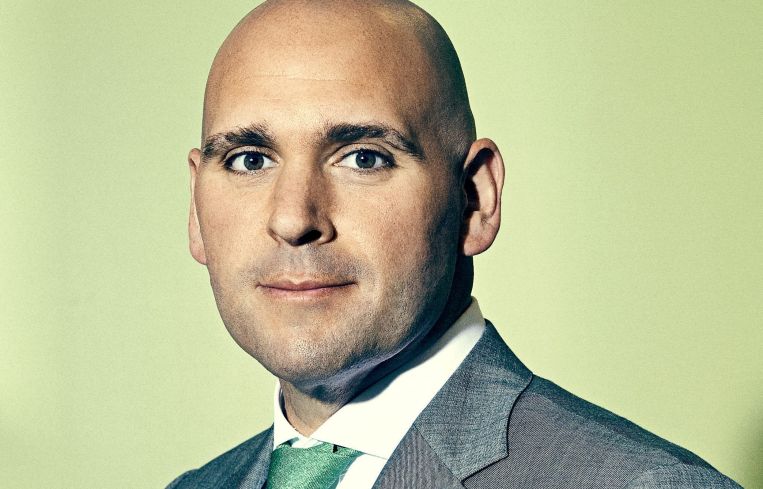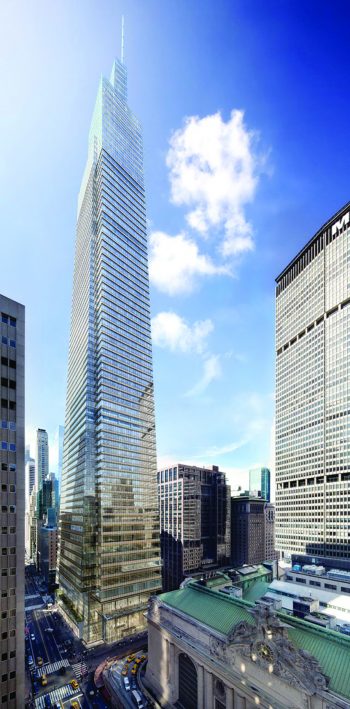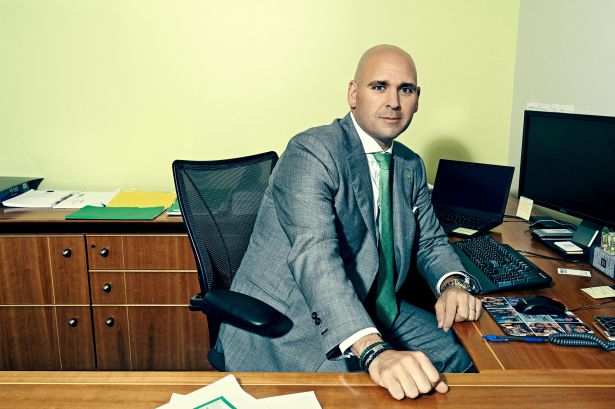David, the Goliath: TD’s David Friedman Wants the Bank to Outdo Itself in NYC
By Matt Grossman June 25, 2019 10:00 am
reprints
In David Friedman’s office, tucked into TD Bank’s suite at 125 Park Avenue, high above East 42nd Street, it’s green everywhere you look. Financial charts tacked to his walls, the file folders on his side table, the room’s paint job. Even the New York regional lending chief’s necktie is slathered in the shade. (A publicist put him up to that fashion statement, he cheerfully admitted.)
The particular emerald hue we’re talking about will be familiar to New Yorkers due to TD’s ubiquitous retail banking presence in the city. Though the institution has been more of a tacit player in commercial real estate lending, it’s nonetheless contributed plenty of its green there, too.
Indeed, you may have noticed that it’s not every day that TD makes headlines as a real estate deal’s sole lender. But don’t let that fool you. As a crucial role-player on giant financing mega-deals so big they require participation from a gaggle of banks, the Toronto-based lender has been attached to some of New York’s most eye-catching projects, from its $200 million contribution to the debt on SL Green’s giant One Vanderbilt office tower to its slice of the $217 million debt package bankrolling northwest Brooklyn’s sprawling Greenpoint Landing multifamily development—a project developed by Park Tower Group with participation by Brookfield (also a Canuck firm, of course).
Covering a footprint that spans the entire East Coast, the bank lent $6.6 billion against real estate assets last year—a volume largely driven by service to big New York City sponsors like Brookfield and Blackstone. And by upping the size and frequency of its collaborations with big-name sponsors like that, TD is hard at work driving that figure ever higher.
In a competitive financing landscape, the climb will be just that much steeper. But if anyone has the dogged perseverance for that task, it’s a good bet that Friedman does. The 38-year-old New Jersey native has had his sights set on making it big in real estate finance since his second semester of college, and recalls landing his first gig in the industry via a tenacious golf-course elevator pitch he made while caddying for an industry exec from PNC. After rising through the ranks at Bank of America, where he led real estate syndicated capital markets, the father of two—who lives on the Upper East Side—joined TD under its U.S. lending chief, Gregg Gerken, last May to bring fresh eyes to its New York City lending presence.
It’s been a busy 13 months.
A week ago, Commercial Observer settled into a Granny Smith-colored office chair across from Friedman’s desk to learn more about his efforts to take TD’s Big Apple lending to new heights.
Commercial Observer: You joined TD Bank to lead its New York City lending last year after more than a decade at Bank of America. What was the transition like?
David Friedman: Going from Bank of America to the scale and size of TD Bank was an adjustment—but one that I expected. The real estate book at Bank of America is approximately $100 billion, and our real estate book here is just shy of $22 billion. Bank of America banks nationally, and at TD we bank the East Coast footprint, from Maine to Florida. I needed to observe and be patient, to get a feel for the lay of the land. Now, at the one-year mark, I feel that everyone from the most junior underwriter to the most senior executive has made a mutual buy-in to where we want to go, and how we will find our way there.
And where do you want to go? What have you tried to do at TD so far?
It’s a function of using some muscles that we hadn’t used in the past. I felt like our “body” in New York was using about 70 percent of its capacity. Now, we’re using about 80 percent or 85 percent.
Growing your loan book, in other words. What’s been the focus of your efforts to achieve that?
The old comment is that real estate is location, location, location. My approach, on the other hand, is sponsorship, sponsorship, sponsorship. The institutional [owners] and the large public funds are definitely of interest [as clients], because they have a tremendous amount of deal flow.
I think most [lending] institutions are challenged today in how to grow, given that it’s so competitive. Our view is that we want to grow with who we know and with where we know. And that means, for us, to bank the sponsors that we want to bank. I think it’s really a function of going deeper with some of our relationships.
Who have been some of the most important names on that list in your first year?
One of the sponsors that we cover in New York is Blackstone, which is one of those institutions that has a bevy of transactions on an annual basis. We had a very small relationship with them a year ago, but we’ve grown that significantly in the last year by participating in a lot of their recently announced acquisitions—and by playing in those transactions at more meaningful numbers. Historically TD has been in the middle to lower tier of bank groups. This is an opportunity to up-tier that, to gain [recognition as a bookrunner]. We’ve done that. Some of the [Blackstone] transactions from the last year, we’ve committed upwards of $125 million to any one transaction. I don’t want to say, “If you like it at $25 million, you like it at $125 million,” but it’s about trying to get as much as you can, for the right risk and the right credit.
Can you tell me about any of the particular deals you’ve worked with Blackstone on?
I won’t speak in specifics about that.
In broad strokes, then, why are those deals attractive? Especially given that it means TD doesn’t always get to be the lead bank.
Well, we’ve [lent against] some big portfolio transactions, and diversification is a very attractive word, especially today. We’re often single-asset lenders, but on portfolios, Blackstone can put together 40, 60, 90 or 100-plus properties. You have the ability to really take an advantageous position in the risk. One of the ways a lot of the larger deals are getting done is a bifurcation between a senior component and one or two tranches of mezzanine.
And TD sees those senior components, paired with a mezz lender, as an appealing spot to be?
It’s a product that I think benefits both the equity and the debt. It’s not the mezzanine of 2007. It’s not rescue capital. Clearly it’s an opportunity for the equity sponsors to find ways to meet their returns, which is ever so hard in a low-cap-rate environment. From a banking perspective, what you’ve done is—appropriately structured and with the right provider—you’ve insulated your position with another quality sponsor that can own and operate the asset at a lower basis. We were not very active in transactions with mezzanine debt until I came.
How did you alter that?
I was very involved in mezzanine at Bank of America, so I understood the product more. And when I came here, I spent the time helping educate the leadership and the risk [officers]. “What are you concerned about? What do you think mezz is today, what don’t you want it to be, and how can it look like something you can get comfortable with?” Through those conversations, we began to understand what the real concerns were. I used my contacts at mezzanine lenders and legal shops to [have people] come in and speak about how things are structured and why. Once you get past those elements, you look at the credit itself. Let’s say the last leverage ends at 70 percent. [For the deal to collapse], I’d have to have 30 percent of the equity completely blow up. And, yeah, if that did happen, now my mezz guy is my borrower—and at a basis where I would have given that person the same exact loan. When you start to peel at those layers, you begin to see how it makes sense.
Which frees you up to more actively pursue those deals as a senior lender?
We’re not at all pushing everything out with mezz. But we’ve definitely increased the transactions that we’re participating in that have a mezz component—or, at least, we’re willing to explore deals that have mezzanine in them.
Give me an example of the sort of deal you’re talking about.
One of the transactions we’ve recently done was for Brookfield and Blumenfeld [Development Group]: the refinance of East River Plaza. [The property is a 500,000-square-foot shopping center that abuts the East River at East 116th Street in Manhattan.] This is 100 percent retail. But it’s phenomenal real estate, built in 2011. That transaction, with phenomenal sponsorship, historically has been well occupied with good sales. Now, there’s this little component of mezz that’s been placed to a well-known real estate fund operator. Should they have to foreclose, they could operate the asset as well as the current owners. We clearly don’t expect that to happen, but that’s the way we approach mezz. If, on the other hand, it’s mezz from a lender that doesn’t have an extended history of owning and operating real estate, that’s not going to be for us.
How did you first get into real estate?
I like telling this story, because my entrance into real estate finance is a unique one and I think it sort of speaks to me as a bit of a grinder. I graduated from Babson College in 2003. We were just sort of coming out of the dot-com crash and labor markets were not great. My father owns a family furniture business in New Jersey that he inherited from his father, who was a Holocaust survivor, and the plan was for me to learn finance and business and then take over [his company]. But I took a real estate course my freshman year, and I fell in love with it. And I came home that summer and had a tough conversation with my father and my grandma. She was everything [to me]. So I had to have this very hard conversation of [saying], “I kind of like this real estate thing and I’d like to give it a shot.” Immediately, they were like, if that’s what you want to do, and that’s what you’re passionate about, go try it.
But I get the sense that that was easier said than done in the early 2000s?
I was interviewing and nothing was happening. People were sort of stale. So I went back to a local country club that I had caddied at for a number of summers, for pocket money. One of the outings they hosted was for a homebuilder, and PNC Real Estate Finance was one of the groups. I handed the caddy master 20 bucks and said, “I need to be the caddy for that group.” So I met [PNC real estate executive] Tom Hyland and had a five-hour interview with him on the golf course. That was Monday, and the following Monday I had an offer.
Tell me about TD’s involvement with One Vanderbilt.
Our support of SL Green is exciting on a number of fronts. You can even see the building out my window, right there. We’ll hopefully be taking our space there as a tenant by the end of this year, and then we’ll move in by, we hope, 2020 or 2021. We were excited to be selected as one of the five leads to do the original construction in 2015, and the deal was recast in 2018 with the announcement of some additional leasing. Not only is TD Bank going to be there, but TD Securities [the company’s advisory and capital-markets branch] has signed a lease as well. Across both companies, we’re going to have about a 300,000-square-foot presence in their building, with a 6,000-square-foot retail branch at the base.

What’s the attraction of being so deeply connected with that particular asset?
It’s the corner of [East] 42nd Street and Madison Avenue. But moreover, it’s a client that we’ve supported for a long time—not only on the product side but also within SL Green’s various corporate lines of credit. It’s exciting to me, especially as New York metro regional director, to have that type of home. It’s exciting to our clients, and exciting to our employees, who will get to work in a new state-of-the-art facility with phenomenal transportation access.
How does TD stand out in such a crowded field? Is there anything you tell borrowers that you do differently?
We don’t have silos for real estate. Some institutions have a CMBS group, a balance-sheet group, a corporate-banking group that covers real estate investment trusts…Our team in New York covers all segments of real-estate sponsors. I think that’s very advantageous, because themes that may be helpful to a REIT may also be helpful to a local retail owner-operator. We can provide advice that we may think is only important to a REIT, but then [another] sponsor hears it and says, “Wow, I wouldn’t have thought of it that way.”

Have you seen the role of debt brokers evolve over the years? How does that cohort affect how you win business?
Look, I think it’s not lost on me or the relationships managers here that the brokerage community is a much larger piece of our business than it ever has been. I think that’s driven by ownership of real estate that is becoming more institutional. So we are now establishing relationships on two fronts: clearly with the sponsor, but with the brokerage community as well. We feel confident that, when it comes to the relationships that are the most meaningful to us, that, while we’re going to be respectful to the process and work with the broker, we also know that there is an ability to influence the outcome [through a direct relationship with the sponsor].
How would you sum up your vision for where you’re trying to take TD Bank in New York City?
When I took a look at this opportunity, I knew it was a good one because TD has a fortress balance sheet. They knew where they wanted to bank and whom they wanted to bank. With this house, you’ve got a phenomenal foundation. Now, you may want to change your room up, push out a wall or maybe even add a new wing, but the foundation that it sits on is as solid as it gets. Now it’s about unlocking [ideas like], “OK, we can do this in a slightly larger size.” Or, “We can do this deal with this type of sponsor multiple times over.” All of a sudden, you can expand and grow this book, creating granularity and diversification and smoothing out the roll of maturities.
Have you ever had such a bad day at the office that you wished you’d stuck to furniture?
Ha! I will take a hard day in CRE 11 days out of 10, and my father will still outwork me in his business. For me, I enjoy the competition with other lenders, the partnerships with clients, and the “hard” of it makes it great. I am fairly certain that my father (and grandfather and grandmother, were they still to be alive today) is proud of not only my professional and personal success, but how I have achieved them.


